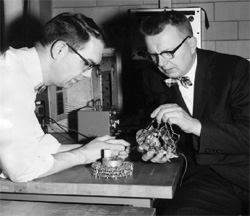From heat budget of the earth to interferometry: Suomi and Parent’s legacy
Initially presented at the 2005 AMS conference in San Diego
Terri Gregory, University of Wisconsin-Madison, Madison, WI; and T. Achtor, J. Phillips, and T. Haig
In the late 1950s, University of Wisconsin meteorology professor Verner Suomi and engineering professor Robert Parent developed basic devices to monitor the earth’s heat budget. They hoped to take advantage of satellite technology just beginning to be developed in the U.S., after the launch of the U.S.S.R’s Sputnik. The two inventors began working out of a room in the basement of the Engineering Building and gradually gathered a group of technical people around them, growing quickly to require a center devoted to the development of instrumentation to monitor the Earth from space, the Space Science and Engineering Center at the University of Wisconsin–Madison founded in 1965. From their early experiments came inventions like Suomi’s spin-scan camera, making it possible to view the earth from geostationary orbit, and McIDAS, making it possible to visualize and manipulate weather satellite imagery on a computer screen.
This presentation shows some of the extant early devices and examines the historical record to trace the development of more current instrumentation from the early inventions. We’ll show the direct line back from instruments such as the Atmospheric Emitted Radiance Interferometer to the early heat-budget instruments. We’ll show how the instruments were used, what sort of data they collected, how the data were collected, and how the data were used. SSEC’s current successful instrumentation development is traced back to the early table top devices that could fit in the palm of your hand.

